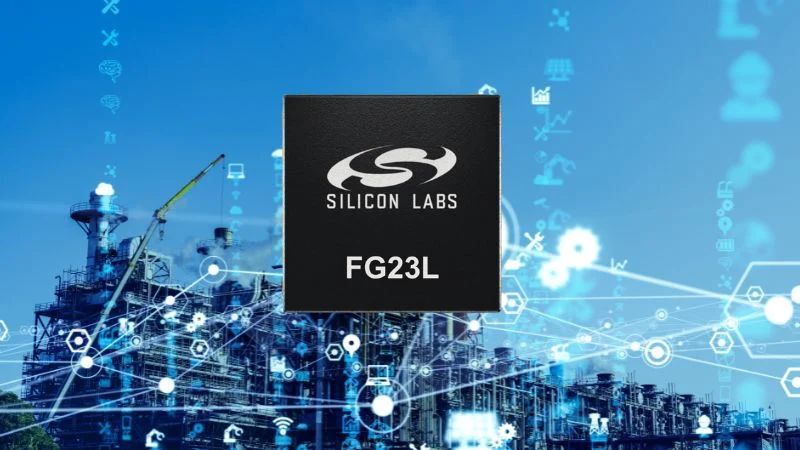Announced today, the company's newest SoC increases small-device edge computing performance while reducing cost and power consumption to deliver a 10-year operating life with a coin cell.
Today, Silicon Labs announced the newest member of its Series 2 system-on-chip (SoC) portfolio. The new FG23L joins the FG23, FG25, and FG28 low-power sub-GHz SoC line. The FG23L will now start the 2 Series out with an Arm Cortex M33 at up to 78 MHz, an M0+ radio core, 128 kB of flash, and 32 kB of RAM. The flagship features are increased range, along with longer battery life. The M33 core delivers 20–50% higher processing performance over comparable parts at a lower price.

The FG23L.
We spoke to Silicon Labs' senior product marketing manager Chad Steider to learn more about the FG23L.
“The FG23L takes what we did with BG22L and BG24L in developing more application-optimized SoCs and brings it over into the sub-GHz space,” he said.
A Sub-GHz System on Chip
The FG23L SoC radio supports frequencies in the license-free industrial, scientific, and medical (ISM) band ranging from 110–970 MHz. The ISM is open worldwide for easy device compatibility. Silicon Labs provides a software radio configurator along with SoC development tools to enable easy radio configuration.
The FG23L complements the FG23, FG25, and FG28 in Silicon Labs’ Series 2 sub-GHz SoC portfolio. It maintains line compatibility in most features and performance statistics for easy migration when more memory or I/O is needed. Housed in a 5 mm x 5 mm QFN40 package and operating at temperatures between -40°C to 85°C, the device features 1x USART, 3x EUSART, and 23 GPIOs.
“The FG23L maintains the same RF performance of the FG23,” Steider said. “It has the same output power and the same link budget. And it gets 1.5x to 2x the range that we see from competitive parts that are currently addressing this space in the market.”
Silicon Labs' sub-GHz wireless SoC offerings. (Click on image to enlarge)
The SoC can deliver up to 20-dBm transmit power for a longer range than competitive offerings without the need for an external amplifier. This meets the maximum allowable power level in many regions around the world. It also offers better reception with a highly sensitive 125.8-dBm receiver module. The SoC is also optimized for long battery life—up to 10 years of life from a coin cell. Active current is 36 µA/MHz, while deep sleep mode (EM2) current is 1.2 µA (when the CPU and HF osc are off; 32 kHz when RTC is on). The transmit mode current comes in at 25 mA.
High Edge Computing Security
The F23L does not skimp on security either. The threat levels for even the smallest Internet of Things (IoT) devices are such that they cannot be ignored. Bad actors can breach unsecured peripherals and use that as a gateway into an otherwise secure main system. The new chip includes a robust set of features to combat such risks, including:
- True random number generator
- Hardware crypto engine
- Secure application boot mode
- Virtual security engine and hardware security engine
- Secure boot with root of trust and secure loader (RTSL)
- Secure debug with lock/unlock modes
- E-tamper detection and prevention
- Physical unclonable function (PUF) support
If additional security is needed, designers can easily migrate up to the Series 2 product line.
Broad IoT Applications
Silicon Labs designed the FG23L for connected products in cost-sensitive markets around the world. Such applications as home automation and security, city sensor networks, access control, industrial sensors, agriculture, and personal entry fobs need long battery life, secure operation, and low cost. The FG23L is designed to give product designers greater flexibility for reducing costs while increasing device performance for these types of uses.
“When we talk about target applications, we're looking at pretty simple applications that typically use proprietary-type networks or those that just need a simple proprietary link,” Steider said. “That's really where 23L is going to shine.”
Current products in the low-cost sub-GHz area often lack performance and feature sets. The FG23L comes with a higher-performance processor (78-MHz Cortex M33 and M0+ radio processor), lower cost, and a solid security and function set, along with lower power consumption. The low cost and 10-year life may support more “install and forget” devices in locations where maintenance and replacement are difficult and expensive.
Development kits are available now, with full part availability on September 30, 2025.



